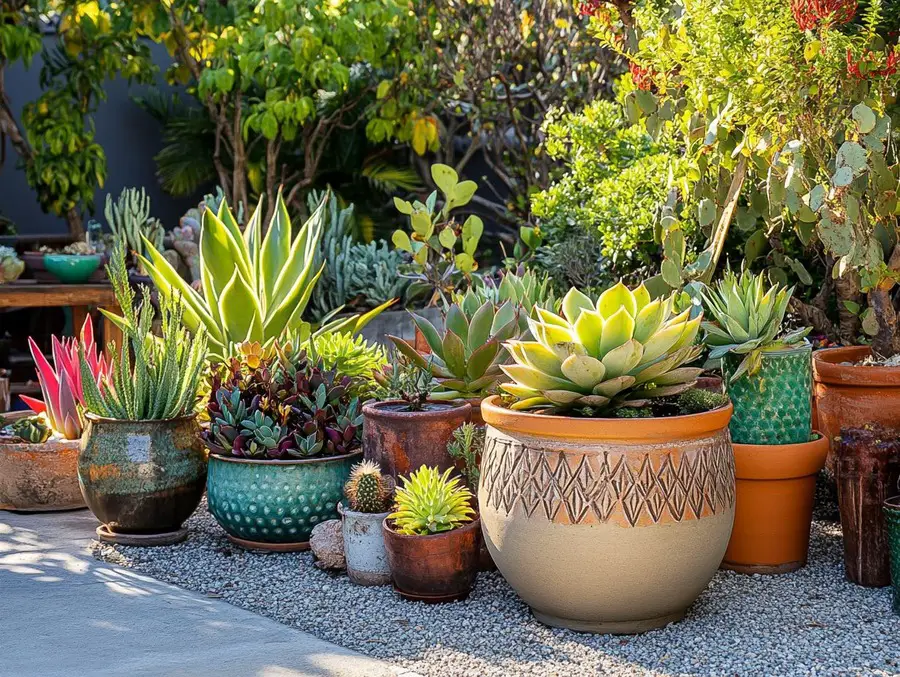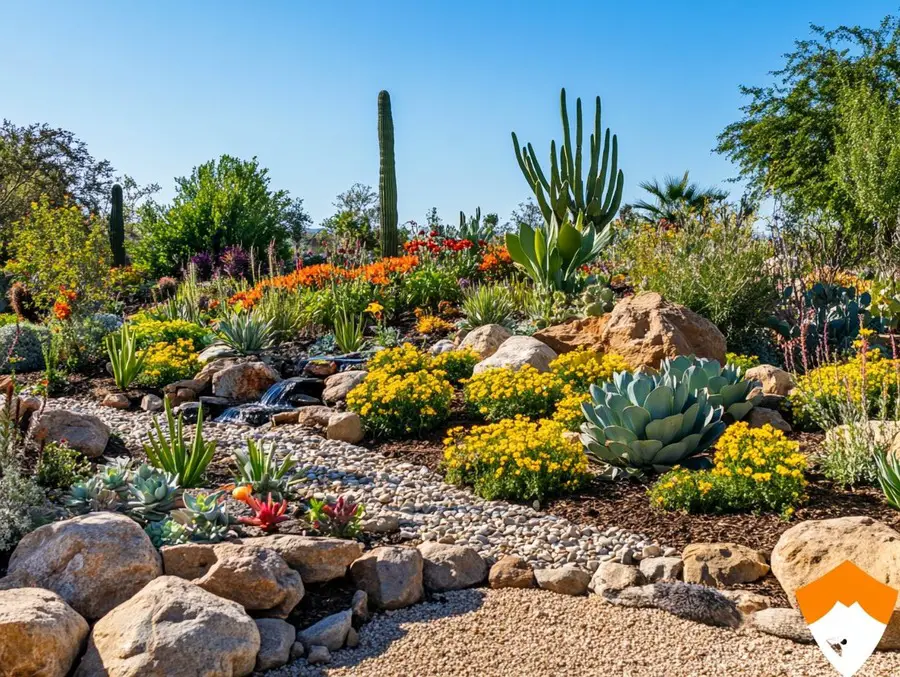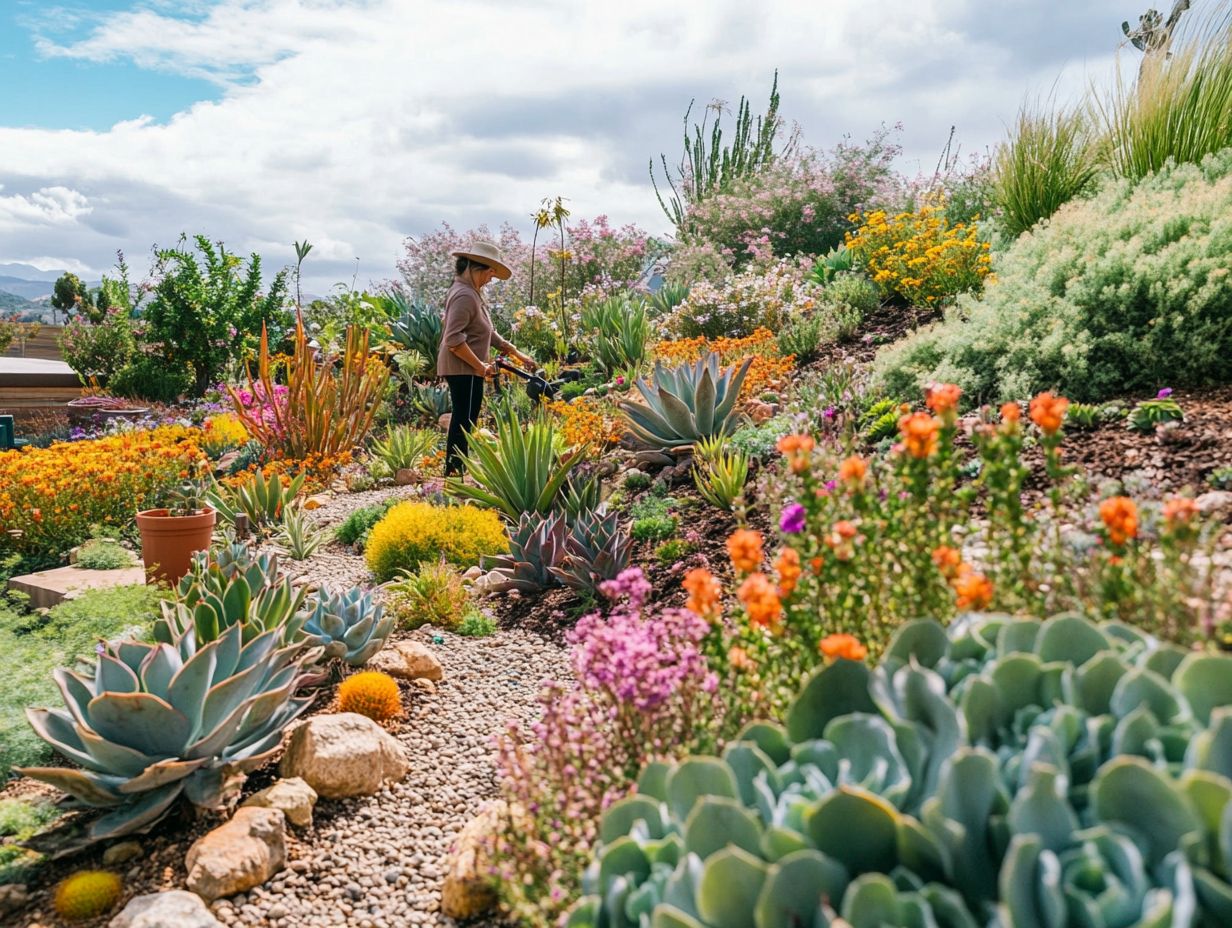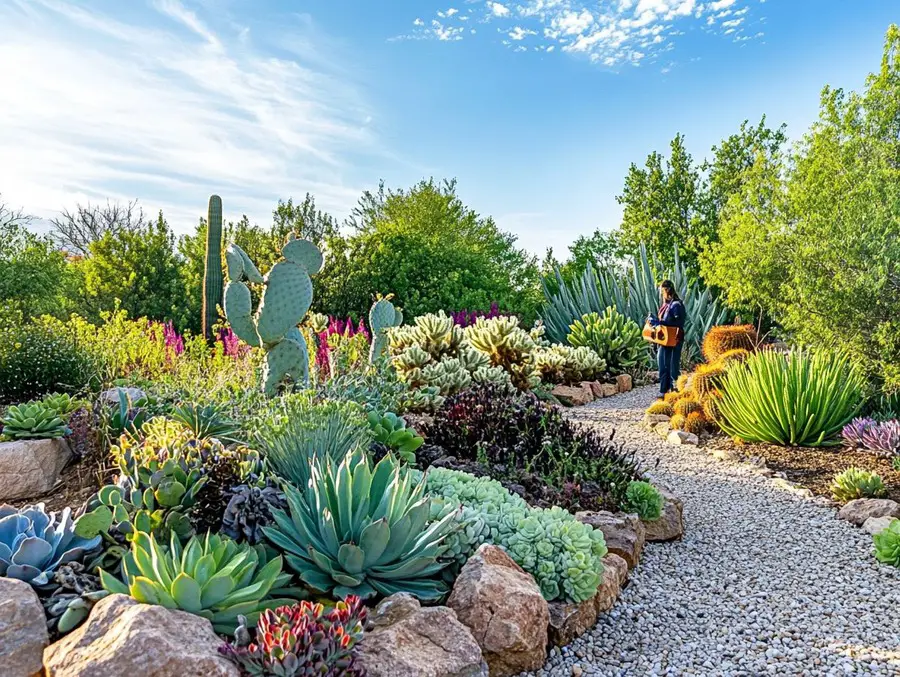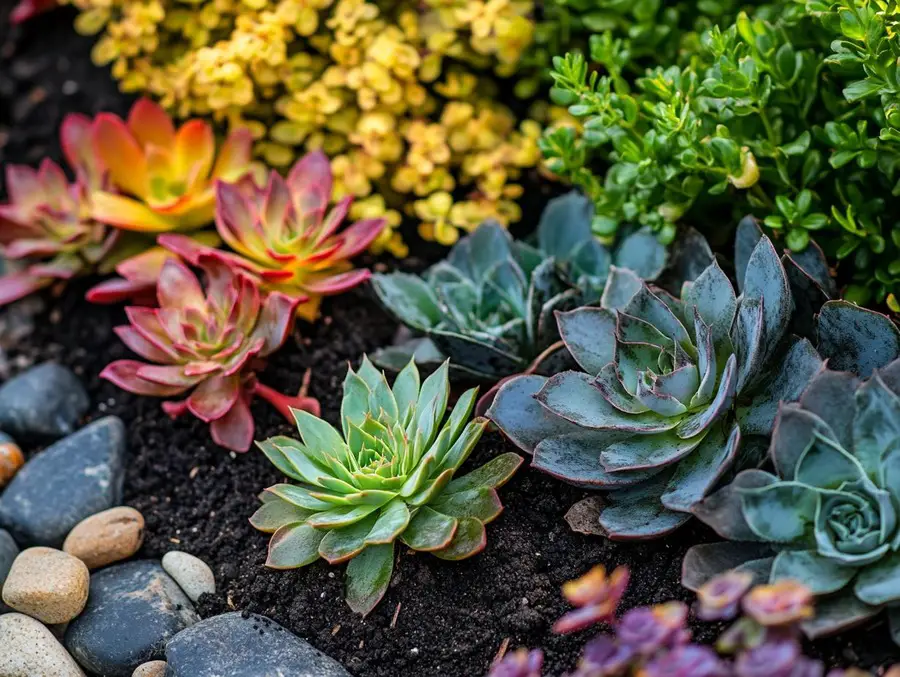We use affiliate links. If you purchase something using one of these links, we may receive compensation or commission.
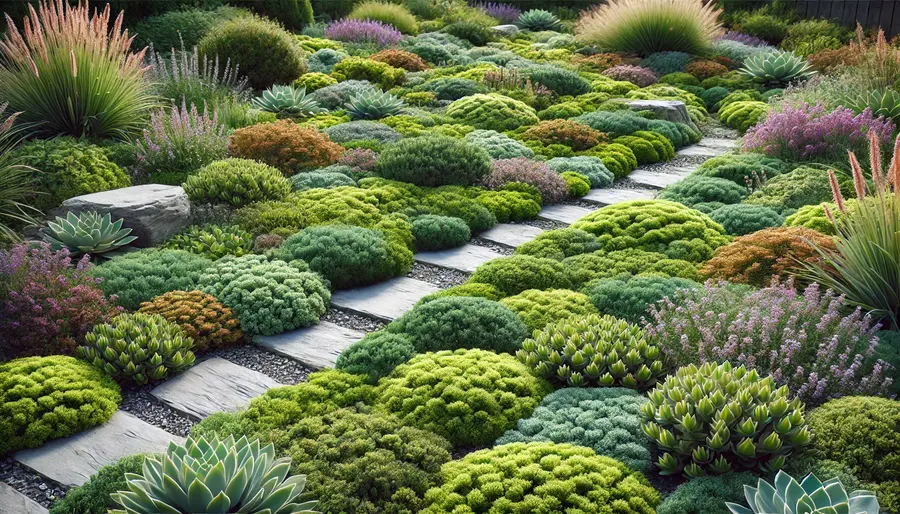
Finding the best ground covers for xeriscaping can transform your yard into a low-maintenance, water-saving paradise.
Without the right plants, bare soil dries out fast, leading to weeds and erosion.
The good news? Drought-tolerant ground covers protect your soil, add beauty, and cut down on upkeep.
Let’s explore the best options for a thriving xeriscape!
Ground Covers for Xeriscaping Key Takeaways
- The best ground covers for xeriscaping include low-water plants like creeping thyme, sedum, dymondia, ice plant, and buffalo grass.
- These ground covers help retain moisture, prevent erosion, and reduce weeds while adding color and texture to xeriscape gardens.
- They’re easy to maintain and thrive in dry conditions with minimal watering.
Best Ground Covers for Xeriscaping: Affordable & Stunning
Finding the best ground covers for xeriscaping can save you water, time, and money while keeping your yard lush and beautiful.
Without the right plants, you could end up with dry, patchy soil or constant weed problems.
The good news? There are affordable and stunning ground covers that thrive in low-water conditions. Let’s explore the best options!
Why Use Ground Covers in Xeriscaping?
Ground covers aren’t just for looks, They’re a smart way to conserve water while keeping your yard low-maintenance.
These plants act as a living mulch, shading the soil to reduce moisture loss and prevent weeds from taking over.
They also help stop erosion, making them a great choice for sloped areas or places with loose soil.
Benefits of Using Ground Covers
- Water-Saving – Covers the soil, reducing evaporation and retaining moisture.
- Weed Control – Blocks weeds from growing by crowding them out.
- Erosion Prevention – Helps keep soil in place, especially on slopes.
- Low Maintenance – Requires little watering, mowing, or care.
- Adds Color & Texture – Creates a lush, polished look without extra work.
By adding drought-tolerant ground covers to your xeriscape, you get a beautiful and functional yard that needs less upkeep.
Best Drought-Tolerant Ground Covers for Xeriscaping
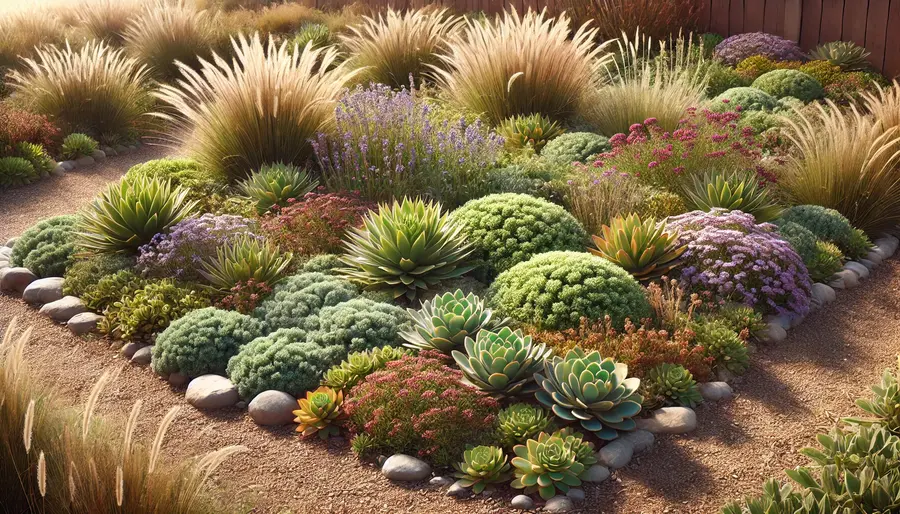
Choosing the right ground cover can make or break your xeriscape.
The best options thrive in dry conditions, suppress weeds, and add color and texture.
Whether you want something soft underfoot, a burst of blooms, or a tough lawn alternative, there’s a ground cover for you. Here are some top picks.
Creeping Thyme
Creeping thyme is a powerhouse for xeriscaping. It spreads quickly, requires little water, and releases a pleasant fragrance when stepped on.
- Low Maintenance – Once established, it needs minimal care.
- Pollinator-Friendly – Bees and butterflies love its tiny purple blooms.
- Drought-Tolerant – Survives with little to no watering once mature.
- Great for Paths – Works well between stepping stones or as a lawn substitute.
Sedum (Stonecrop)
Sedum, or stonecrop, is a hardy succulent that thrives in tough conditions.
With hundreds of varieties, you can find one that fits your space.
- Thrives in Dry Soil – Needs very little water to stay healthy.
- Comes in Many Colors – Choose from green, red, purple, or variegated options.
- Cold Hardy – Many varieties can handle frost and extreme weather.
- Low Growing – Forms a dense mat, making it great for erosion control.
Dymondia
Dymondia, also known as silver carpet, is a fantastic alternative to traditional grass.
Its dense, gray-green foliage creates a soft, lush look.
- Great Lawn Replacement – Forms a thick, cushion-like mat.
- Handles Foot Traffic – Can be walked on without damage.
- Chokes Out Weeds – Grows tightly together, leaving no space for weeds.
- Heat and Drought-Resistant – Perfect for hot, dry climates.
Ice Plant
If you want a ground cover that bursts with color, ice plant is a showstopper.
Its bright flowers bloom throughout the warm months, making it a favorite for dry gardens.
- Heat-Resistant – Thrives in full sun without fading.
- Low Water Needs – Can survive on rainfall alone in many areas.
- Fast-Growing – Spreads quickly, covering large spaces.
- Variety of Colors – Comes in purple, pink, yellow, and red shades.
Buffalo Grass
Buffalo grass is a top pick for those who want a natural-looking lawn without the hassle.
It’s one of the few grasses that can handle xeriscaping conditions.
- Extremely Water-Efficient – Survives on 50-75% less water than traditional turf.
- Soft Underfoot – Provides a comfortable, barefoot-friendly surface.
- Thrives in Heat – Perfect for hot, arid regions.
- Minimal Mowing – Only needs occasional trims to maintain shape.
These ground covers are not only tough but also beautiful, making them perfect for xeriscaping.
Next, let’s talk about the best ways to plant and care for them!
How to Plant and Maintain Xeriscape Ground Covers
Planting xeriscape ground covers the right way ensures they establish quickly and thrive with minimal care. The key is choosing the best planting method, using proper spacing, and following simple maintenance steps. Here’s what you need to know.
Best Planting Techniques
Getting your ground covers off to a strong start is essential. Whether you’re working with seeds, cuttings, or nursery plants, follow these steps:
- Prepare the Soil – Loosen compacted soil and mix in sand or compost for better drainage.
- Space Plants Properly – Check the mature spread of each variety to prevent overcrowding.
- Water Deeply at First – While drought-tolerant, young plants need consistent watering until roots are established.
- Use Mulch Between Plants – Helps retain moisture and prevent weed growth while plants spread.
- Plant in the Right Season – Early spring or fall is best for most ground covers to avoid extreme heat stress.
Minimal Care Tips for Ground Covers
Once established, xeriscape ground covers require very little upkeep.
Here’s how to keep them looking great year-round:
- Water Occasionally – After the first few months, deep but infrequent watering keeps roots strong.
- Weed as Needed – Until plants fill in, remove weeds to prevent competition for nutrients.
- Prune or Trim – Some fast-growing varieties, like creeping thyme, may need occasional cutting back.
- Monitor for Pests – While generally pest-resistant, keep an eye out for aphids or snails on succulent varieties.
- Replenish Mulch – A light layer of mulch keeps soil healthy and prevents evaporation.
With the right planting and care, these ground covers will thrive, saving you water, time, and effort.
Best Ground Covers for Xeriscaping: FAQs
Choosing the right xeriscape ground covers can raise plenty of questions, especially if you’re replacing a lawn or starting from scratch.
Below are some common questions and answers to help you get the most out of your low-water ground covers.
Q. What is the best low-maintenance ground cover for xeriscaping?
A. Creeping thyme, sedum, and dymondia are among the easiest xeriscape ground covers to maintain.
They require little water, minimal pruning, and naturally suppress weeds.
Q. How do I replace my lawn with ground cover plants?
A. Start by removing existing grass and preparing the soil with compost or sand for better drainage.
Choose a drought-tolerant ground cover, space plants correctly, and mulch between them to prevent weeds while they establish.
Q. Do xeriscape ground covers need fertilizer?
A. Most thrive in nutrient-poor soil and don’t need much fertilizer.
However, a light application of compost or organic fertilizer in early spring can encourage healthy growth.
Q. How long does it take for ground covers to fill in?
A. Growth speed depends on the plant type.
Fast spreaders like ice plant or creeping thyme can fill in within a season, while slower growers like buffalo grass may take a year or more.
Q. Can I walk on xeriscape ground covers?
A. Some, like dymondia and buffalo grass, can handle light foot traffic.
For more durable options, consider adding stepping stones in high-traffic areas.
Q. How do I keep weeds out of ground cover plantings?
A. Mulching between plants, proper spacing, and occasional hand weeding help keep weeds at bay.
Once fully established, dense ground covers naturally suppress weeds.
With the right choices and a little patience, xeriscape ground covers can transform your outdoor space into a low-maintenance, water-efficient oasis.
Xeriscape Garden Design & Layout: Easy Water-Wise Beauty
What is xeriscaping? A beginner’s guide to drought-tolerant landscaping
Related Content
Visit my Amazon Influencer Page for videos and gardening products Grow Your Own Garden

